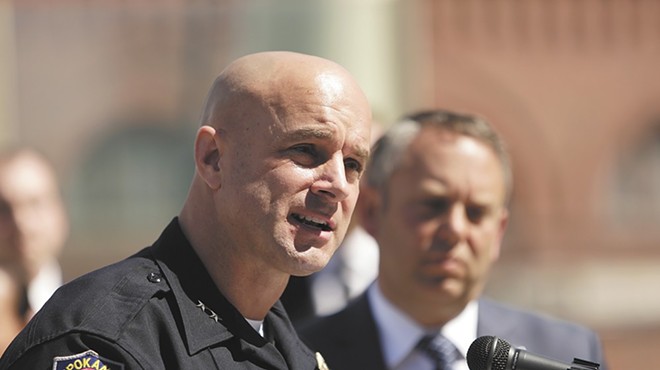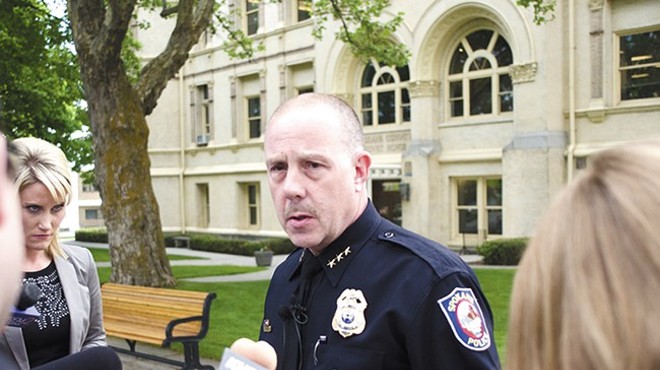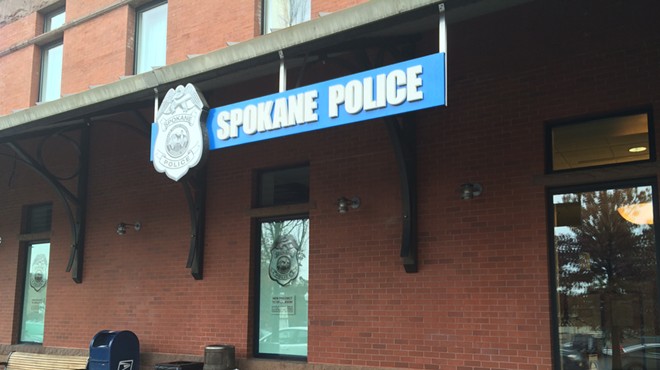Thursday, March 24, 2016
Last April, police chief told city the plan was to keep police stationed near STA plaza

Last April, the police chief told city administrators directly that the plan was to keep some police officers at the Peyton Building (pictured here during its 2013 opening) after moving the precinct to the Intermodal Center.
Back in January, we at the Inlander were trying to untangle the decision-making behind the controversial decision to shut down the hard-won police presence in the Peyton Building near the Spokane Transit Authority Plaza and move the police precinct east to the Intermodal Center.
Up until October 2015, the City Council, the STA and the Downtown Spokane Partnership were under the impression that the plan was that at least some officers would remain stationed at the Peyton Building.
In January, Scott Simmons, then the city's director of the business and developer services, told the Inlander that as far as he was concerned, the Intermodal Center had been planned as a replacement facility since at least March 2015, and the Peyton Building facility would be shut down.
"My understanding was the plan was always to vacate the Peyton [Building] and move to the Intermodal [Center]," he explained. "In my mind, we were not doing both locations."
But an email recently obtained by the Inlander features Police Chief Frank Straub informing Simmons, explicitly and directly, that keeping some officers at the Peyton Building was his plan.
The
We'll quote the relevant section in its entirety, bolding for emphasis:
3- DowntownThe email was also sent to Mallahan and then-Asst. Chief Rick Dobrow.
- Focus is on opening the precinct in the Intermodal with plans moving forward at this point. Would be nice to off-set construction costs. We envision keeping the current location as it has become well-recognized by the public and businesses as well as STA. Our current plan is to move precinct to Intermodal, reconfigure the precinct's coverage area to "connect" downtown — east Sprague university district. The current location may house our chronic offender and community outreach (led by Lt. Meidl).
The Inlander reached out to Simmons, intending to ask whether he read this e-mail, responded to it, or remembered it. He declined to participate in an interview. "I spoke with Scott Simmons and he said — he asked me to relay this message to you — he does not have anything further information to add from his last interview with Mitch," said Julie Happy, spokesperson for Simmons' department.
You might be wondering whether the minutiae surrounding a police department facility move matters. It does, for a number of reasons. The move, and the lack of communication around the
While a proposal from the police department this week has asked STA to chip in for an officer concentrating on the plaza, their ask would be $28,900 less than was being paid last year.
On top of that, the move sparked a convoluted back and forth between the city and the police department over furniture that resulted in Capt. Brad Arleth being put on paid leave for an entire month while an internal affairs investigation was conducted. (The investigation concluded Arleth was insubordinate by moving and dismantling furniture against orders; Arleth claims the instructions were unclear and confusing.)
Not only that, Arleth was chided and interrogated for publicly criticizing the decision to shut down the Peyton Building facility. He denies claims that he said crime would increase if the Peyton Building was shut down. The city, however, has made the argument that crime would likely be reduced around the Intermodal Center. (So far crime appears to be down downtown.)
Mostly, the email revelation serves to bolster all the other evidence that for most of 2015, no decision had been made for the police force to leave the Peyton Building entirely. When did that change? Who ultimately made the decision to shut down the Peyton Building location?
Despite city council members asking multiple rounds of questions like these of the city, City Council President Ben Stuckart says the council still doesn't know exactly what happened. The two police department members listed as the points of contact with the city — Straub and former Assistant Chief Selby Smith — are now both gone. They were the only names the city cites as having being consulted when making its decision.
Besides the email, plenty of evidence contradicts Simmons' notion that vacating the Peyton Building was always the plan. A few examples:
• Straub told city council members in February 2015 that “Our intention is to open both desks. The desk that’s downtown that’s currently opened and staffed, that would stay open. And then we would open the desk down at the Intermodal also.”
• In April of 2015, according to DSP Business Improvement District board minutes, DSP President Mark Richard said Assistant Chief Rick Dobrow told him the department "had no intention of closing" the Peyton Building facility.
• At the May BID board DSP meeting with Mallahan in attendance, minutes say Richard explained that in his conversations with Dobrow about the Peyton Building facility, he said "the situation is fluid but they have no intention of closing it" and "Capt. [Brad] Arleth offered that he feels it wouldn’t make sense to close the facility downtown."
• In June, BID board minutes show Arleth told the BID board the "downtown facility may be assigned to the chronic offender team."
• In September, after Chief Frank Straub had been fired, Arleth told the BID board that "with the recent change in leadership, plans for the Downtown precinct were uncertain."
The recent IA investigation into Arleth
• Arleth testified that, during the summer, plans were changed to move the South Precinct into the Intermodal Center, and the downtown precinct would "stay in the Peyton." A few weeks later, he said, it turned to neither precinct moving. It was only in October, Arleth said, that he learned the police department was going to vacate the Peyton.
Later, he testified that “various times during the year we were told, you know, we’re moving this date, moving that date, no, we might move chronic offenders into the Peyton. We might move somebody else in there, but they’ll still be cops.”
• Sgt. Kurtis Reese also says in the summer it wasn't clear if the downtown precinct was going to transfer to the Intermodal at all, saying “we didn’t know who was going to go there. It was gonna be the South Precinct, then it was gonna be the Downtown Precinct… it was kind of going back and forth as to where we were going to be.”
“So along that string of kind of confusion, [the plan to move] was basically stopped and started several times as to what was going to happen and how that was going to happen,” he said.
• Asst. Chief Craig Meidl reiterates the shifting plans for what was going to happen with the Intermodal move.
"I never received any clear communication on what the end goal was going to be and when Chief Straub left the agency, I think a lot of that knowledge probably left with him of what the ultimate goal was going to be.”
Meanwhile, several other facts have called into question whether city staffers had a clear understanding of the basic facts surrounding the move to the Intermodal Center. In answering the council's initial round of questions, the city claimed the "STA lease expired at the end of December 2015." In fact, the lease being paid for the DSP doesn't expire until May 2016.
• In e-mails, City Asset Management Director Ed Lukas repeatedly told City Administrator Theresa Sanders that new furniture had been purchased specifically for the Intermodal Center. But after looking at city records and precincts, Major Justin Lundgren determined
Similarly, Sgt. Reese noted that the Intermodal Center's flimsy, coffee-stained desks were not new, but rather from “from the City Hall basement that
The City Council is still waiting on their public records request to clarify what went wrong.
Tags: Intermodal Center; STA; Downtown Spokane Partnership; Scott Simmons; Brad Arleth; Frank Straub , News , Image













![[UPDATED] Downtown police captain returns to work as new Intermodal Center office comes under scrutiny from employees](https://media2.inlander.com/inlander/imager//u/r-big16x10/2678987/thanks.jpg?cb=1681255561)
















